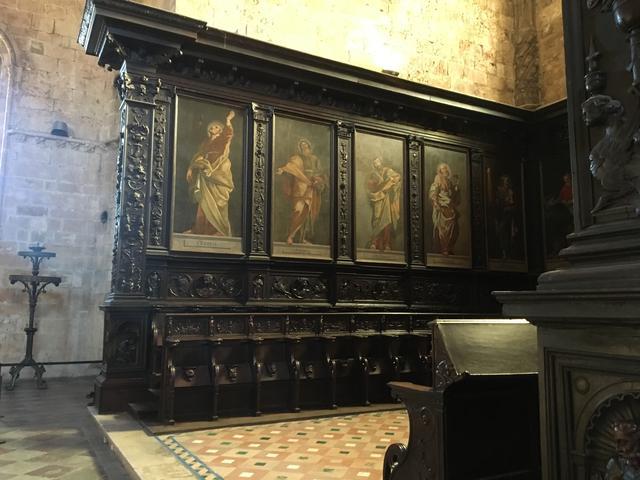high choir

We reached the high choir, a raised platform, with a view of the main altar of the church. To the right is a magnificent Renaissance-style seat for the monks, a true masterpiece of art and craftsmanship. This stunning seat was designed by Diogo de Torralva and executed in 1550 by the master Diogo de Cácera. The intricate details of the sculpture work are truly remarkable and deserve to be admired up close. The seat is adorned with exquisite carvings, including vases, young heads, warriors, and fantastic animals, showcasing the skill and creativity of the artisans who crafted it.
Originally consisting of 84 chairs, the high choir suffered damage during the earthquake of 1755, resulting in the loss of 24 seats. Despite this, the remaining chairs still retain their beauty and historical significance. The paintings on the back of the chairs date back to the 16th and 18th centuries, depicting ten of the twelve apostles. Unfortunately, the canvases of Saint Peter and Saint Paul were lost during a renovation of the church, but the remaining artworks provide a glimpse into the religious art of the time.
In addition to the chairs and paintings, the high choir also features four additional paintings near the door leading to a terrace. These paintings include depictions of Saint Augustine, Triumph of Faith, Triumph of the Eucharist, and Saint Jerome in a cardinal's red suit and hat. The presence of these artworks adds to the overall grandeur and spiritual atmosphere of the space. At the center of the balcony stands an image of the crucified Christ, crafted from wood and attributed to the Flemish sculptor Philippe de Vries. This sacred piece was a gift to the monastery from the infant D. Luís, son of D. Manuel, in 1551, further enhancing the historical and religious significance of the high choir.
The high choir was a vital space for the monks' prayers and communal worship. Known as the "Divine Office," the monks would gather in the choir seven times a day to pray, recite, and sing. The seating arrangement allowed for a combination of sitting and standing during different parts of the prayer, with the monks relying on the "mercies" for support. This ritual of prayer and contemplation was central to the monks' daily lives, emphasizing the importance of spiritual devotion and community worship within the monastery. The high choir stands as a testament to the artistry, faith, and history of the church, inviting visitors to experience its beauty and significance firsthand.
© ChatGPT 3.5